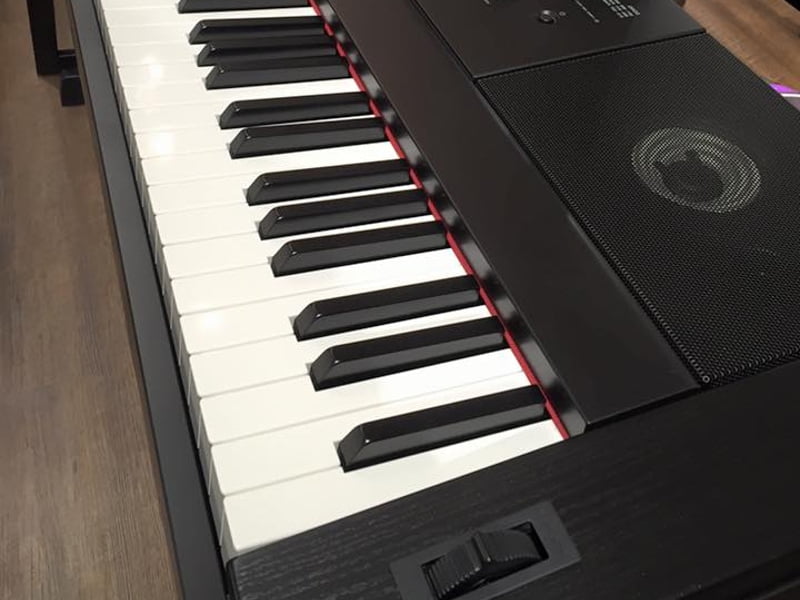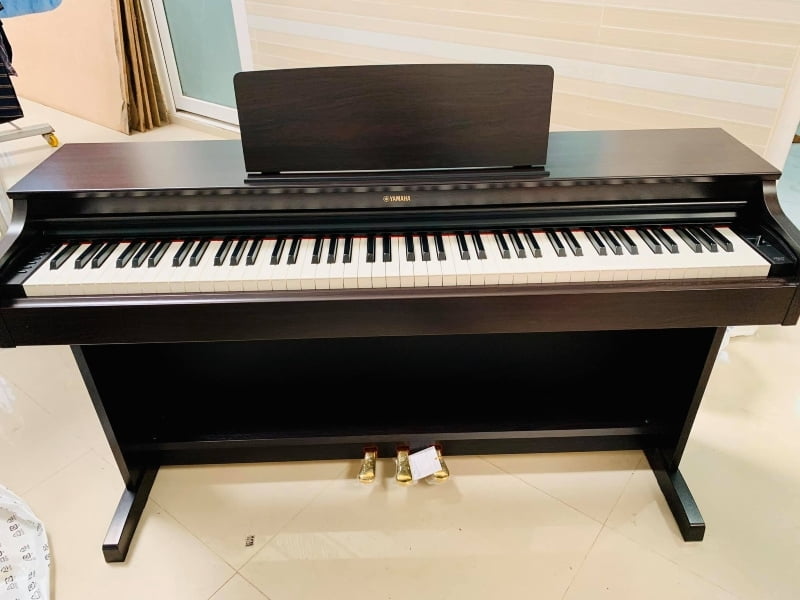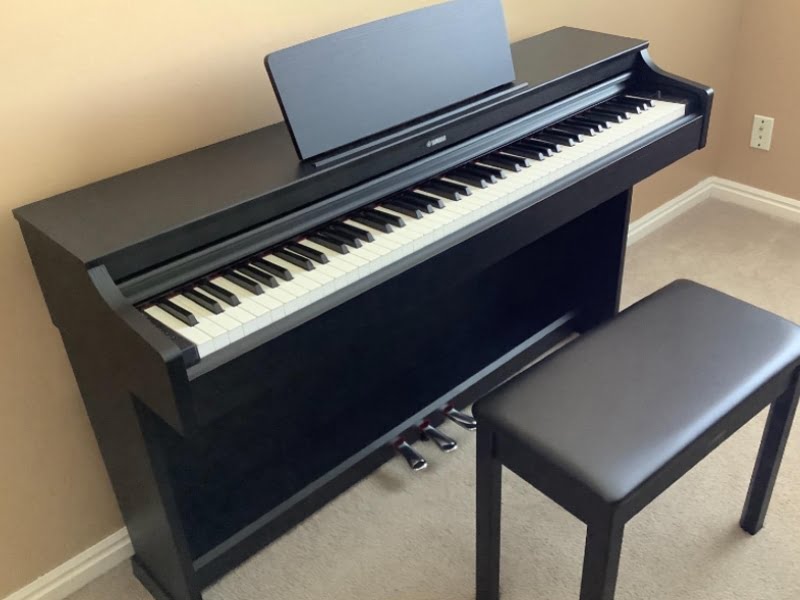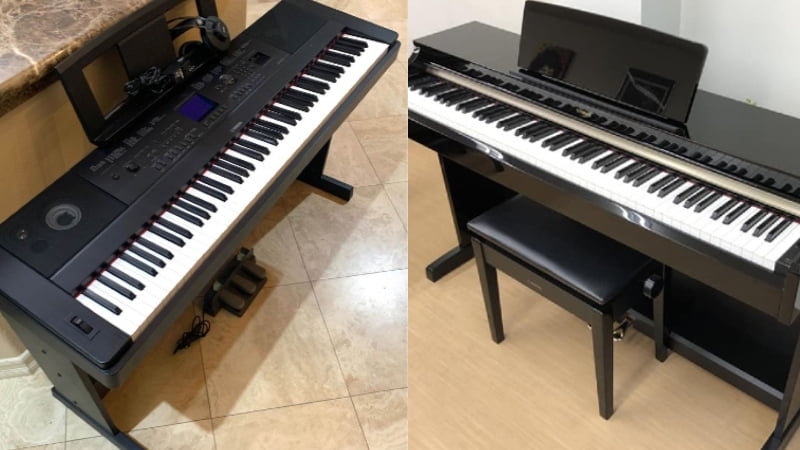In this Yamaha DGX-660 vs YDP-163 match-up, we compare two great Yamaha pianos to help you find the best option for your needs.
Yamaha is one of the most reliable and versatile brands when looking for digital pianos. They have tons of options, all of which make for great instruments. And in this Yamaha DGX-660 vs YDP-163 comparison, we’re finding the best one.
These are some of Yamaha’s best pianos that come with great features and offer a lot of value for the money. And when I compared the pianos myself, I found that the Yamaha DGX-660 has a slight edge due to its versatility.
The YDP-163 is best for those looking for a more traditional piano. But if you need a modern instrument that’s versatile and fit for any genre or style, you might prefer the DGX-660.
In the rest of this comparison, I’ll look into the details and features of both models. And by the end, it will be much easier for you to choose the best one for your needs!
Yamaha DGX-660 vs YDP-163: Comparison Chart




Last update on 2025-07-03 / Affiliate links / Images from Amazon Product Advertising API
Yamaha DGX-660 vs YDP-163: A Head-to-Head Comparison
I judged these pianos based on three main categories – tone, feel, and piano features. These are what I consider the most important features of a digital piano. And when using these three comparison points, the Yamaha DGX-660 edges out a 2-1 win.
Both pianos have their own set of advantages, and they are obviously made for different types of pianists. So, while I think that the DGX-660 offers more value for the money, there are many people out there that might prefer the YDP-163.
And below, I’ll get into the details of this comparison. That way, it’ll be much easier for you to figure out the best fit for your needs.
Tone
The winner: Yamaha DGX-660
The first feature I looked at also happens to be the most important characteristic of a digital piano – the tone. And since both pianos come with the same tone generator, you can expect the same sound quality from either model. That said, I noticed that the YDP-163 has a very limited sound library, which isn’t ideal for musicians that need a large variety of sounds.
And for that reason, the Yamaha DGX-660 wins this point.

+Tone Generation
These pianos come with the Pure CF Sound Engine. This is one of Yamaha’s older sound engines, but you can still find it on many pianos because of its versatility and sheer quality. And while it has a fancy name, I found that this is basically a sample-based generator that uses higher-quality samples than other engines in its price range.
The piano sounds on the Yamaha DGX-660 and the YDP-163 are both derived from Yamaha’s CF Grand Pianos. One of the reasons Yamaha is so good at making digital pianos is that they also make acoustic pianos, with the CF Grand Piano being the creme de la creme of their collection.
So, whenever you press a key on the DGX-660 or the YDP-163, you play a recording of a Yamaha CF Grand Piano. This is why you get really rich, bright, and realistic tones from both instruments.
This tone engine used to be the most sophisticated option Yamaha had to offer. However, that has been replaced by the CFX tone generator, which you’ll find on newer models. While I had no problem with the Pure CF Sound Engine, it would have been nice to see the CFX option on the YDP-163, as it’s the more expensive model.
+Sound Library
While you can expect similar tone qualities from both pianos, their sound libraries couldn’t be more different. The YDP-163 is a more traditional take on the digital piano that focuses on quality over quantity. So, you only get around 10 voices on this piano but rest assured that they are all top-quality and very realistic.
The voices on the YDP-163 include a range of piano voices, a few strings options, and some bass tones. This covers most of your needs as a performing pianist, but there’s no denying that this is also a very limited selection of sounds.
The DGX-660, on the other hand, do things much better. This modern digital piano comes with over 550 different voices. So, aside from the common tones you get from a digital piano, you can also experiment with various synth and drum sound packs.
That said, many of the DGX-660’s voices aren’t produced by the Pure CF Sound Engine. This is why there’s a slight dip in quality when you start going to the unique tones like guitar, synth, drums, and SFX.
But while I was let down by the inconsistent quality of the Yamaha DGX-660’s tones, there was no denying that it was the more versatile and flexible option.

Feel
The winner: Yamaha YDP-163
The next characteristic I checked out was the feel. You always want your digital piano to have a similar, if not identical feel to an acoustic piano. And between these two options, the Yamaha YDP-163 has a very slight advantage. In the section below, I’ll explain why the YDP-163 wins this point.
+Hammer Action
The Yamaha DGX-660 comes with the Graded Hammer Standard or GHS. This is one of the best hammer action systems that Yamaha has to offer and usually wins out when you compare it to another piano. This is because the GHS captures the small weight differences you get on an acoustic piano, adding another layer of realism.
That said, the YDP-163 comes with an even more advanced hammer action system. This piano comes with the Graded Hammer 3 or GH3 system. This does a lot of the same things that the GHS does, but it also has a faster spring-back action.
When you plan a premium acoustic piano, you’ll notice that the keys bounce back faster than on a cheap one. This is what the GH3 system aims to replicate, and it does a great job of it. So, while this is a very small detail, it makes a huge difference for many pianists.
Piano Features
The winner: Yamaha DGX-660
My last comparison point was the extra piano features that you get from the instrument. And since both pianos have the exact same maximum polyphony and 192 and a similar set of effects, I was about to call it a tie.
But that’s when I looked at the bigger picture. While the Yamaha DGX-660 and the YDP-163 have a similar set of piano features, the DGX-660 holds an advantage. This is because the DGX-660 is a more affordable piano.
On top of that, the DGX-660 is portable, so you can easily bring it around. The YDP-163 is bulky and designed to stay in one place, limiting your options greatly.
This means that you get much more value for the money with the Yamaha DGX-660. And since it’s the more flexible option between the two, I would highly recommend investing in this option instead of the YDP-163.

Yamaha DGX-660 vs YDP-163: The Similarities
These two pianos are not short of similarities. Despite belonging to completely different price ranges and being designed for different pianists, they share a lot of features. For example, both pianos come with split, duo, and dual modes. These are considered the essential playing modes for most digital pianos and allow you a lot of flexibility and bring a lot of room for experimentation.
On top of that, these pianos share a tone generator. While the DGX-660 comes with more voices, the piano tones of this model and the YDP-163 come from the same source. So, if all you need are piano tones, these two instruments are pretty much the same.
But at the end of the day, flexibility matters to me as it does for many other musicians. So, if you want a piano that you can use at gigs, lessons, and at home, you’re better off with the DGX-660.
Quick Rundown of the Yamaha DGX-660
- The Pure CF Sound Engine faithfully reproduces the tone of a meticulously sampled and highly acclaimed Yamaha concert grand piano
- GHS weighted action is heavier in the low register and lighter in the high, just like an acoustic piano
- Score display puts music notation of MIDI songs on the screen, helping you play your favorites by following the bouncing ball
- The Piano room lets you choose from a variety of pianos and acoustic settings to create your own personal piano environment
- The 6 track recorder allows you to capture your performances and song ideas, then add additional layers to spice up your pieces
Last update on 2025-07-03 / Affiliate links / Images from Amazon Product Advertising API
Quick Rundown of the Yamaha YDP-163
- The Pure CF Sound Engine faithfully reproduces the tone of a meticulously sampled, acclaimed Yamaha 9' CFIIIS concert grand piano, allowing for incredibly dynamic and expressive playing.
- Graded Hammer 3 (GH3) weighted action provides increasingly heavier touch from the high keys to the low keys, with grand piano-style response and an outstanding dynamic range.
- 50 classic piano songs are provided in the built-in song memory as well as in a music book, "50 Greats for the Piano."
- The Controller App for iOS devices adds a rich graphical user interface, allowing for quick and easy navigation and configuration.
- The 2-track song recorder allows players to practice one hand at a time, or record their next hit single!.No of pedals:3
Last update on 2025-07-02 / Affiliate links / Images from Amazon Product Advertising API
Product Video
Related Articles to Yamaha Dgx 660
- Yamaha YDP-164 vs DGX-660: Why You Should Go for the DGX-660
- Yamaha DGX-660 vs Roland FP-90: Why the Roland FP-90 Is the Better Pick
- Yamaha DGX-530 vs 660: Why the DGX-660 Is the Better Pick
- Yamaha DGX-505 vs 660: Why the DGX-660 Is the Better Pick
- Yamaha DGX-660 vs DGX-640: A DGX Comparison
- Yamaha DGX-660 vs DGX-630: A DGX Comparison
- Yamaha DGX-620 vs 660: Finding the Best DGX Model
- Yamaha DGX-660 vs Roland Juno DS-88: Which Is the Better Piano?
- Yamaha DGX-660 vs Casio PX-360: Which Is the Better Piano?
- Yamaha DGX-660 vs YDP-144: Which Is the Better Yamaha Piano?
- Yamaha DGX-660 vs Korg Havian 30: Which Is the Better Digital Piano?
- Yamaha DGX-660 vs Casio CGP-700: Which Is the Better Pick?
- Yamaha DGX-660 vs YPG-535: Finding the Best Yamaha Digital Piano
- Yamaha DGX-660 vs P515: Is the P515 Worth the Extra Cost?
- Yamaha DGX-660 vs P-115: Which Yamaha Model Is Better?
- Yamaha DGX-660 vs Casio PX-560: Which Piano Offers More Value For The Money
- Yamaha DGX-660 vs 650: A DGX Comparison
- Korg XE-20 vs Yamaha DGX-660: Finding the Best Digital Piano
- Yamaha P45 Vs DGX-660: A Head-to-Head Comparison
- Yamaha DGX 670 Vs 660: The Distinct Difference In Details You Need To Know About
- Yamaha YDP-103 Vs DGX-660: Which Is The Better Yamaha Piano?
- Casio PX-770 Vs Yamaha DGX-660: Should You Get A Portable Or Console Digital Piano?
- Yamaha P71 vs DGX-660: Can the Amazon Exclusive Beat Out the Premium Model?
- Yamaha P125 vs DGX 660 Comparison: Can the P125 Hold Its Own Against the DGX 660?
Related Articles to Yamaha Ydp 163
- Yamaha YDP144 vs 163: Which Is The Best Arius?
- Casio PX-870 Vs Yamaha YDP-163: Which Digital Piano Is The Better Option?
References:
- Yamaha DGX-660: https://usa.yamaha.com/products/musical_instruments/pianos/p_series/dgx-660/index.html
- Yamaha YDP-163: https://uk.yamaha.com/en/products/musical_instruments/pianos/arius/ydp-163/specs.html#product-tabs
Lulacruza is an electronic folk duo operating at the junction of the hypermodern and the ancient. Our music weaves together hypnotic female singing, South American folk instruments and electronic processing, while channeling pulsating waves from the source of creation.
Lalucruza is also a community where you can connect with other music lovers to collaborate, exchange ideas and share knowledge. A platform for who wants to learns the basics of playing piano, guitar, drum masters’ technique, etc.. is the premise of our website.
